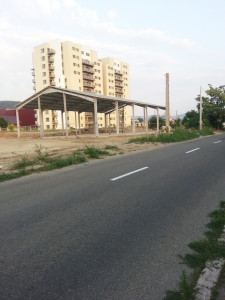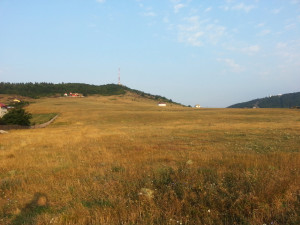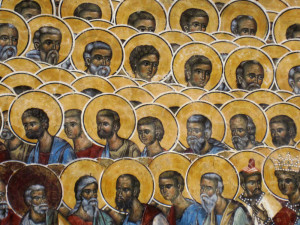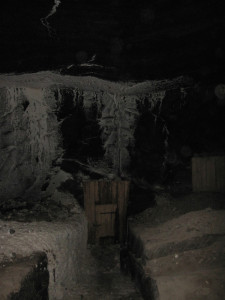Trip to the North Golden Retriever
.
Abraham Kritzman, Angels Miralda, Marlene Steyn
What makes a myth?
Repetition
Interpretation
Cyclical time
Episodic

Introduction
Images flashed past, waters overflew in numerous directions, and as if we had experienced the fall of Babel, we were dispersed throughout the world. Memory was erased in the most violent of ways. The total proliferation of images short-circuited our memory systems and we lost balance on the delicate mental workings between neuron and transmitter. Only our iPhones survived. An accidental backup appeared on one of our phones – images from a past life in Paris, even old messages from friends who were now dispersed through other portions of the globe. These images looked foreign but familiar, as if they would nearly trigger a real memory but were incapable of doing so. We had all somehow met in London, we had left, and somehow run in to each other once more on our way here.
Time had accelerated to such a degree that it collapsed. There was no time any longer but rather the simultaneous happening of everything at once. Populations were displaced, mass migrations to capitals and the eventual fleeing back out to peripheries. We met many people on the way to this place, they might be thousands of lives away by now, we might have lived with them for years in crumbling city blocks but we forgot their faces.
Arrival in Piatra Neamț
A pilgrimage is a spiritual or morally significant journey. Usually it is done towards a shrine or object relevant to the faith of the pilgrim. Here however, our memories were only able to recall the stories of our families, about their ancestors having been from this town.
We told stories of the wood mill and guessed where it might have been. We asked ourselves why the family left this city and what we would be doing now had they remained. We organised a pilgrimage to explore the city through the image of the mother wolf. The mother wolf gave sustenance to the men who founded Rome. In the Carpathian range, the wolf still exists in numbers, in this city we would found memory. 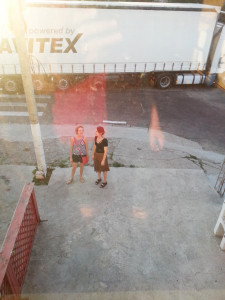
Arriving in the outskirts of the city we witnessed a number of incredible structures. Churches with twisting spires, decorated with saints painted in detail and brazen backgrounds. An enormous factory out in the distance, stark grey and eminent shape contrasting with the green fields, the rolling pine hills, the blue sky with soft sheep’s wool clouds. We stayed outside the center, in a dark and damp cave above a dreary looking club called Sky Club. From there, we excitedly planned our journey around this town.
All night we heard the howls of dogs. Packs of stray dogs trotted up and down the street as if they knew we had arrived. They gathered outside the cave waiting for the sun to rise.
The Code of Gloves
A guide to follow on the pilgrimage
- We draw a map of a double wolf over the city plan. The double wolf is a representation of our arrival in the Carpathians, of our submission to wilderness, fate, and the mother wolf. The double wolf throws its head up towards the sun while eating a human leg while its second head looks down at the ground.
- We begin at the anus, which is the location of our cave. From there we move down to the tip of the tail. After we do the long stretch of the back of the wolf until we reach the tip of its carnivorous nose. At this point we will eat and rest. From here we go down to the second head. In the eye of the second head we will pay homage to the eminent objects of the city in the town’s art museum. From this point we will continue down to the river, to the claw of the wolf. After this, we will drink from the teat and the underbelly of the mother wolf. A second trip down the hind legs to another point of the river, and finally, back to the anus.
- We will not approach objects. Instead we will touch objects with the back of our hands in devotion. We will not absorb objects ourselves, but rather ask another member of the expedition to absorb the object or image for us.
The Undertaking
At the break of dawn we exited the cave. A howling wind spread ahead of us while the dogs looked on. They scurried about in groups, watching us from afar. The morning colors made the area look even stranger than it was. Beginning from the anus, we first encountered the scraggly pieces of the under tail. Fast food restaurants and sun bleached circus posters, decaying walls and overgrown lots of land. Like most of the world, this area was unwelcoming, but we had grown into it. Upon arrival we doubted whether to stay in the cave, but now it didn’t seem as daunting. 
The dogs followed us for a while before leaving us behind. We stopped at a gas station that was drenched in shadows. The wind whipping past as we drank warm tea to keep ourselves warm, already shivering and frigid. Other dogs would find us on this journey and begin barking behind fences, following us with their howls. 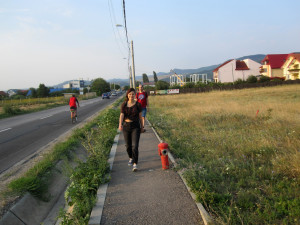
The wind swept debris up into the air and rustled the thorny bushes of chaotic growth. We persisted down the uneven paths, the cracking asphalt that gave way to rocky dirt. Tall blocks of flats with walking passages connecting the buildings appeared alien in a landscape of rusted metal and rock.
The tip of the tail happened to be at a curved bridge over a small stream. This stream signaled the washing of the land, everything became new, clean, spacious, and inviting. Houses neatly laid out with fences by newly asphalted roads sat modestly by agricultural fields rolling from the road to the distant hills. On this road we saw the presence of other walkers, other humans on the trail – not necessarily of the double wolf, but a trail of their own. Cars passed us by as we walked past an astronomical observatory. The heart of the wolf. Inaccessible to us as outer creatures, but visible and wonderful. 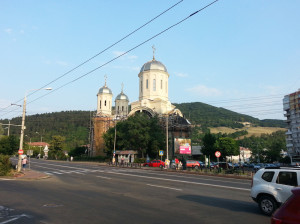
All along the back of the double wolf the city evolved, but it kept an impersonal feel and the distance between buildings stayed at a degree that was indicative not of a city but of a suburban town. It was only towards the neck of the double wolf that the density picked up, at the edge of the urban center, a large cemetery full of white marble crosses entered our path. At the center was a church, modest in size but big enough to act as protectress of the graves. We walked through the dry land between tombstones, Buildings began to pile on top of each other. Tall flats – but not blocks – sat together along large roads, big supermarkets, a flow of pedestrian traffic, lights.
The buildings emerged out of the landscape. Large hills propping up curved buildings. Bridges flying between the edifices over small canals and soccer fields. The silver roofs of churches sparkling brightly under the now-blue sky. The heat had set in and bathed everything in a golden light. We were entering the first head of the wolf. This was the wild one, the angered and hungry one, the one that would devour the human foot.
The path turned from asphalt sidewalks to a rock and dirt path that ascended steeply up the
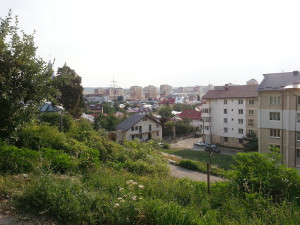 largest hill in the area. Vegetation creeped in around us until any architecture was blocked from our view. As the slope steepened the path became a forest trail and the trees shaded us from the high noon sun. Swerving through the
largest hill in the area. Vegetation creeped in around us until any architecture was blocked from our view. As the slope steepened the path became a forest trail and the trees shaded us from the high noon sun. Swerving through the  dense forest we found the trail quite easily to the top. There stood an old ski resort closed for the summer– everything
dense forest we found the trail quite easily to the top. There stood an old ski resort closed for the summer– everything 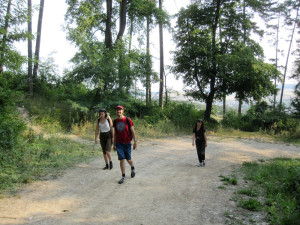 was still in place but locked up. A wooden structure at the very top of the mountain. A café that must serve warm drinks in the winter still had its coffee signs and warm chairs inside, visible only from the windows. We climbed to the very top, to the roof of the cabinesque
was still in place but locked up. A wooden structure at the very top of the mountain. A café that must serve warm drinks in the winter still had its coffee signs and warm chairs inside, visible only from the windows. We climbed to the very top, to the roof of the cabinesque  construction. From there we saw everything spread out before us – an entire city with roads and
construction. From there we saw everything spread out before us – an entire city with roads and
traffic, buildings sprouting up like
stone trees and vines around the
bends of the geographical terrain. To the right was a great blue lake sparkling in a thin valley. The lake was artificial, we saw the damn structure gating in the waters and thought that was where the woodmill must have been. This deserted mountaintop served as the tipping point of our journey.  We could now see the territory beneath us, as in a revelation, the city surrendering to the gaze, opening up generously.
We could now see the territory beneath us, as in a revelation, the city surrendering to the gaze, opening up generously. 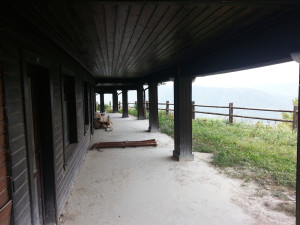
The cabin provided us with a table and benches over the view of the
lands below. There we sat as the wasps prepared a lunch for us. Pieces of ham, bits of cheese, a tub of hummus, a couple tomatoes, laid out on the table with fruits and bread, and sweet honey baklava. We feasted in the sun, imagining what lay ahead on our journey through the city with a sweet breeze on our faces and smiles to the god high noon sun.
Only an ominous turn could have driven us from such a place. We were at the teeth of the first head of the double wolf. As the wasps had laid out the table, so they returned to the feast. As we realized the food had not been laid out for us, but for their colony we retreated from the table. Their disappointment in the state of their meal was evident in the frenzied manner in which they flew about, circling us, smelling our mouths and faces, deciding on what to do next. More and more wasps flew around the table and we quickly retreated down the mountain.
Past the forest maples, down the trail towards the city, we lost them. Soon we arrived in a small village just before entering the town. Wooden gates stood at the entrance to the village. A sign hung down spelling out “Outlaws Cave.” We entered and saw a group of people drinking behind those gates. Children played in the central common area that was surrounded by private dens. The architecture was of a traditional variety of wooden structures, humble but cozy interiors facing towards the common center.
We sat down and the group offered us a drink. They did not interact with us but let us sit at a table with them. A man played a strange instrument and sang in a husky voice in an incomprehensible tongue. We were at the throat of the double wolf. We swallowed our wine and portions of sour soup before leaving quietly.
We headed down the slope towards the second head of the wolf. This was the tame wolf, with a lowered head in reverence. Before we passed into the tame head we encountered a field of wild animals. They all sat together in an enclosed space. Red squirrels sat with European brown bears, a raccoon and a small deer. They watched as we passed the gates bidding us good luck for the rest of our journey. 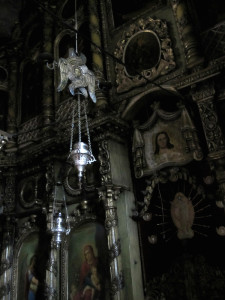
Not far from them we encountered the second head of the wolf. A beautiful piazza opened up in front of us. An old church sat on one end of the piazza with several museums on the other side, and cafes flanking the edges. The church was rich and decorative inside, hosted invaluable objects of silver gilt hanging from the high ceiling. Here, in Orthodox tradition, we paid reverence to the icons and kissed their semblance.
We stayed a while in the church before moving on to the art museum across the square. It was locked up and the curator was upstairs. We rang an old bell and it took her some time to descend the stairs. It was as if nobody had visited for a while. Our pilgrimage took us here, to this cultural center of the city and we paid homage to the objects kept inside. The art museum is packed with objects of the local painters. Incredible tapestries and the sculptures of prestigious town members. We speculated as to which artists our families had known or admired or if any of them had made something now housed in this structure. 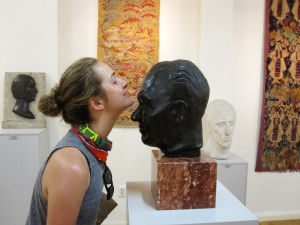

After spending hours in the museum we noticed our incredible fatigue caused by the arduous journey so far. We retreated across the piazza and down a set of carved marble stairs to a green park intricately gardened with sculptures and shady trees strewn about to create a comfortable and welcoming scene. In the shade of the fruit trees we slept soundly for hours. On waking up, we ate the berries of the trees and some nuts we had brought with us. Nobody had been suspicious of our long nap or foreign presence in the park. Once rested at the tame head, the double wolf called us forward to continue our itinerary. The next step was to follow the neck down to the leg and reach the claw at the river in the West of the city.
The walk down the neck and the leg brought more large roads with heavy traffic. Shops of all sorts lined the streets. The sun was high and beat down on us creating lazy footsteps and rims of sweat on our brows. The river seemed to require an eternity to reach after resting in the days’ heat. Once we saw the river it appeared to be behind a large motorway with fast-paced traffic and a couple of train lines. We approached the traffic reluctantly and concentrated on breaks in the traffic to jump across lanes. Full of adrenaline and dripping sweat onto the hot pavement. Once we had crossed, we ran past the train lines looking out for oncoming wagons. As we looked further on we saw that a tall fence had been erected all along the river as to keep the people from it.Was there a reason for this caution? 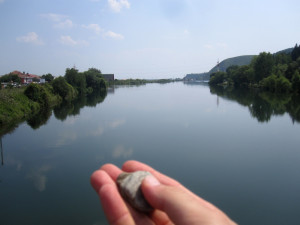
At that moment one of us fell to the ground and began to scream.
“Help, help, ow!”
A wasp had stung her behind the arm and more were gathering nearby. Suddenly, everywhere we turned there were wasps flying about, walking, mating, and eating. The claw of the wolf was a wasp stronghold.
A slight panic broke out among the group. We all ran back to the train lines where we leaped across and found our way past the lanes of traffic once again. Carrying the stung one up the leg of the wolf once more, it was only once we reached the teat that we found a pharmacy. The poison had begun to inflame a large area of the arm with a red rash traveling up. An ointment was applied to the sting and the venom removed. After the sting, a couple members of the expedition abandoned the journey in fear of what completion of the pilgrimage might bring. From this point we only had to complete the underbelly before returning to the back claws, and finally, full circle to the anus. A couple of us continued Southwards down the teat. 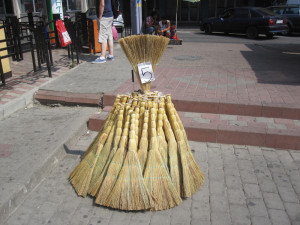
Mama wolf was kind here and provided us with shady trees to shelter us from the sun. A large market appeared in front of us with every kind of fruit and vegetable. Provisions could be bought here for the rest of the journey. We ate milky watermelon slices and sweet grapes. We walked down the hind legs refreshed and ready to complete the pilgrimage. At a small canal we threw wishes into the water and disposed of our troubles  and burdens. A feeling of freedom and lightness emerged. The canal carried away troubles in its small stream of water and we followed it down towards the river.
and burdens. A feeling of freedom and lightness emerged. The canal carried away troubles in its small stream of water and we followed it down towards the river.
As we arrived to the second claw, we saw that the road had been completely blocked. There was no access to the river. We peeked through a hole that revealed an empty wasteland with burned cars and dry grass. The wasps proliferated here as well, taking over the air in swarms. After retreating up the hind leg we easily found our way back to the anus just past the McDonalds and a petrol station.
As soon as we got back to the anus and into the cave above Sky Club, we collapsed. There we found the other members who had abandoned the expedition. The double wolf had been wild and unforgiving; she had kept her secrets from us while tenderly staying of a mother breed. We stayed the long night in the cave together listening to the howling of the stray dogs and staring through a hole in the roof at the glistening stars above us. The constellations visible from the bed made the outline of the double wolf. We slept for 4 days before the sun reappeared on the horizon.
Campulung Moldovenesc
Grandmother came to meet us at the door.
“Come in, come in children! Go to your rooms and put down your things, you have been away for a long time. Please get settled and we will meet for dinner when you are ready, the food will be prepared shortly.”
We put down our bags, the clothes were heavy with sweat of the previous day and the dirt that had stuck to us from the hours of walking across the heat. We put all of this away, we bathed in cool fresh water, and wore fresh clothes that had been kept clean in the rooms. 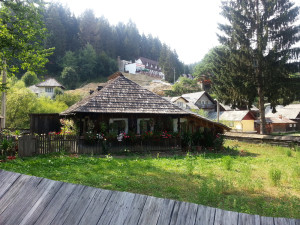
We met in the garden, surrounded by gnomes with their red hats and white beards. They would keep the spirits away from the garden. Fruit trees provided apples and plums. Roses grew in large arches that formed shade from the sun. We sat on rocks and straw chairs that reclined in the garden as the sun set behind the apple trees. The vegetation softly swept back and forth in the light breeze and stars began to appear. 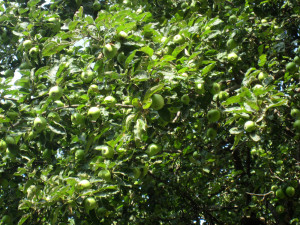

We had dinner with our family, but we didn’t recognize any of them other than grandmother. There were two men, two women, and three children. One girl about 15 years old, a boy of around 4 years, and a little girl just over 1 year. We had never seen them before. Grandmother and her partner, another older woman, ran about the room preparing plates and bringing food. Pickles, polenta, braised pork, sour cream, an array of cheeses, and cherry tomatoes fresh picked from the garden. Full of food and plum brandy, we slept like babies, logishly, and without moving. 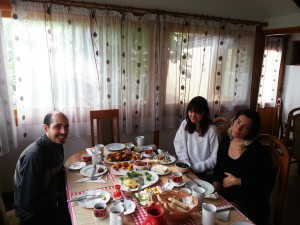
On waking up, grandmother made us breakfast before sending us off to pray. This area is sacred. Monasteries lie in every valley; it is typical to visit them, to pay homage to these holy sites. But it wasn’t a pilgrimage like we did before because it wasn’t organized into a route. It wasn’t a discovery but rather a repetition, an exhaustion, an episode. 
We went to as many as we could, walking and devoting our breath of prayer to those beautiful hues of green, red, and lapis lazuli blue. The familiar figures of Christ, Mary, St. John the Baptist, and the many other saints began to come back to us. We finally remembered the stories that had been so familiar to us. Scenes of Lucifer damning the souls of sinners into streams of hot magma. 
First we came across Agapia. A white building in an enclosed garden of roses. The balconies surrounding the central church burst with well-tended flowers. The images are realistic in their appearance and the church invites you in down the nave until you stand under the cupola. 

Our next stop was Voronet, famous for its lapis lazuli blue. Wonderful paintings in registers frescoed onto the interior and exterior walls. Each scene painted in such detail and in such vibrant colours. Voronet was followed by the Annunciation Church of Moldovita, the church built by Petru Rares, in the museum tapestries of extraordinary colours laid out next to fine metalwork. The Resurrection Church in Sucevita with its famous green. Sucevita with the motif of the ladder dividing heaven and hell. The church of St. John the Baptist in Arbore, a place that looks nearly abandoned, bleached by the sun. Unlike the others, this one is not a monastery and does not have as many visitors, virtually alone in the space we found the silence on the inside of the church calming. Finally the church of the dormition of the Mother of God in Humorului. 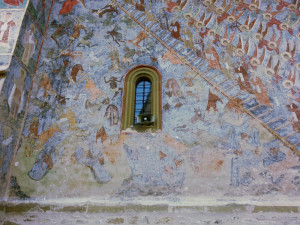
Here at Humorului, we climbed the medieval tower to a high lookout. Inside the tower was yet another staircase. We climbed it and appeared above the clouds somewhere in the mountains, closer to the astral bodies, to the constellations themselves.
Mount Rarau and the fall from the heavens
Two huge pillars of granite stood out from the mountains. They towered over us and over the world. From here we could see all. The poet Ovid pointed over the landscape and told us as he pointed in two opposite directions:
“That is where you came from, and that is where you will go” 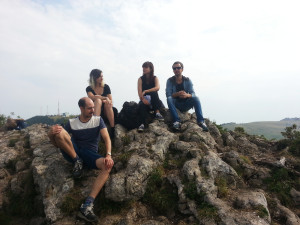
A thunderous clap resounded over the Carpathian mountains. We looked below and saw the cities crumbling. Buildings collapsed. Roofs caved into themselves and objects began to fall to the ground. The sound of bricks hitting concrete melded with the furious barking of caged dogs. The ground became invisible from the dust and falling rubble. All that emerged into the sun were those two never ending granite peaks and the determination of Ovid who had not stopped pointing. 
From this point, everything disappeared. The mountain fell from beneath us as we escaped down the TransRarau. We would take an eternity to fall from those high gates close to the holy sun into the darkest abysses of deep earthen mines. White waters streamed down the mountain and pushed us with them as we attempted a doomed escape. 
I cannot accurately express how many centuries we spent spinning in mid air. Rocks tumbled with us down to eternity. During this fall there was no control over speed or direction, only fate could have her say. As we tumbled down, we barely noticed that darkness fell. It took 500 years for the sun to fully set, but once it did we reached the ground.
It was not any ground whatsoever. We found ourselves in the pits of a salt mine hundreds of meters below the earth’s surface…

Biographies
Angels Miralda
Angels Miralda is currently a Ph.D. candidate at the Royal College of Art in London where she writes on installation and contemporary art theory. She is also an independent writer and curator working as well as manager of Lychee One Gallery in East London.
Abraham Kritzman
Abraham Kritzman is a visual artist working with painting, sculpture, and installation. He is currently a tutor at the Bezalel Academy of Art in Jerusalem and at the School of Visual Art in Kaye College, Beersheva.
Marlene Steyn
Marlene Steyn is a visual artist working with painting, sculpture, and installation and is based in Cape Town, South Africa. She graduated with an MA in Painting from the Royal College of Art.

